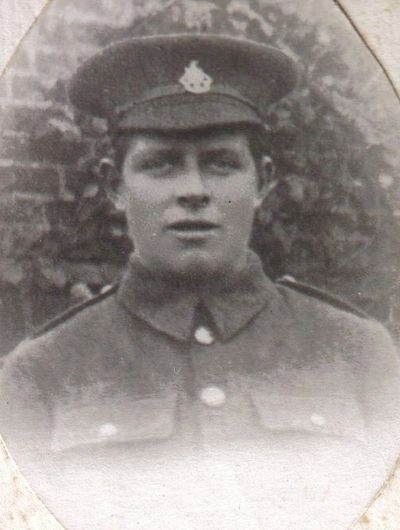Private sydney arthur brooks

Early Years
Sydney Arthur Brooks was born in Fletching in 1898, the second son of Jared Brooks, a bricklayer born in East Grinstead, and his wife Frances, who was from Newick. By 1901, Sydney was living with his parents, an older brother William, an older sister Frances, and his maternal grandfather, William, in one half of Cherry Tree Cottages, Fletching Common. Sydney attended the village school between 1905 and 1911.
The 1911 census shows Sydney was indeed still at school and also still living in Cherry Tree Cottages. Frances was not at home, but William was with their parents, but apparently unemployed. There was also a new younger sister, Lily.

Joining up
Sydney joined up on the 11th November 1914 in Lewes. He was therefore underage, as he was still only 16 years old.
SD1632 Private Sydney Brooks sailed for France on 4th March 1916. His brother William clearly joined up at the same time (he was also underage, as he was only 17), as his Regimental Number was SD1633.
The prefix to these numbers stands for ‘South Downs’ and was given to men who joined the 11th, 12thor 13th Battalions of the Royal Sussex Regiment. Both of the Brooks brothers joined the 12th Battalion.

Attack at Boar's Head
The War Diaries of the 12th and 13th show that both formations had been in and out of the front line since their arrival on the continent in March. By the 29th June 1916, both battalions were in the Ferme de Bois/Richebourg area awaiting the attack, following a period of practice for it behind the lines. The detailed orders for the plan of the attack show that the intention of the action was to capture both front and support lines in the area of the Boar’s Head. To this end the 12th and 13th Battalions were to capture these positions and hold them, forming a new front line, the 12th on the right, and the 13th on the left of the assault. The 11thBattalion, Royal Sussex Regiment was in reserve, making the attack a very local affair.
Following a short bombardment, the Sussex men attacked at 3.05am on the morning of 30th June 1916. The War Diary of the 12th Battalion is short and to-the-point:
‘Battalion attacked enemy front and support lines and succeeded in entering same. The support line was occupied for about ½ an hour, and the front line for 4 hours. The withdrawal was necessitated by the supply of bombs and ammunition giving out and the heavy enemy barrage on out front line and communication trenches preventing reinforcements being sent forward.’
By 10.00am the battalion had been relieved and was marching to billets at Les Lobes. A figure entered in the margin of the 12th Battalion’s War Diary shows that the casualty figure for the day was 412 men killed, wounded or missing. Privates Sydney Brooks and Charles Hodges were among them. Sydney’s brother William survived the attack.
The War Diary of the 13th Battalion gives a more detailed account of the events of the day, but in essence the 13th Battalion’s experience was clearly much like that of their comrades in the 12th Battalion. They managed to occupy limited parts of the German front and support line but were forced back owing to fears that they would be cut off. The only extra detail of significance is the effect of a smoke screen designed to mask the advance, which drifted into the attacking formation causing great confusion, especially in the darkness of early morning.
The battalion was relieved at 1.30pm and marched to billets in Vielle Chapelle. The War Diary does not give complete casualty figures, but Paul Reed, (a leading authority on the Royal Sussex Regiment during the Great War) gives a total figure of nearly 1,100 men killed wounded or missing from the three Battalions (a company from the 11th Battalion had gone forward as a carrying party and had been almost completely wiped out). Hence casualties in the 13th battalion were even higher than those in the 12th

Commemorating Sydney Brooks
Sydney Brooks (aged only 18 years) has no known grave and are commemorated on the Loos Memorial, which forms the outer walls of Dud Corner Cemetery situated in a bleak spot next to the busy N43, the Lens-Bethune road.
The Royal Sussex men are commemorated in a circular apse, and are among over 20,000 men killed in the area with no known resting place recorded on the walls. Sydney’s name lies two above that of another Newick lad, Charles Brown, killed in 1915. The name ‘Dud Corner’ is thought to refer to the number of unexploded shells found in the area after the armistice

The Victory and British War Medal
Sydney Brooks was awarded the Victory Medal and the British War Medal.
Sydney's brother William survived the 30th June attack, but was wounded in July 1918.

This website uses cookies.
We use cookies to analyze website traffic and optimize your website experience. By accepting our use of cookies, your data will be aggregated with all other user data.